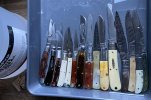- Joined
- Dec 26, 2004
- Messages
- 292
A number of years ago a mastersmith who had just made me a ivory handle knife said to use Tung Oil on ivory and stag. Wipe it on, let it dry then wipe it down. I have been doing it for years and I have had no problems with the stag or ivory.






